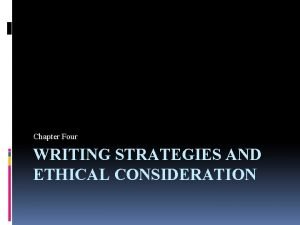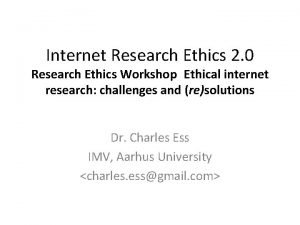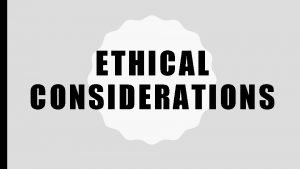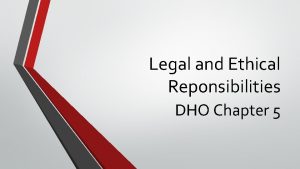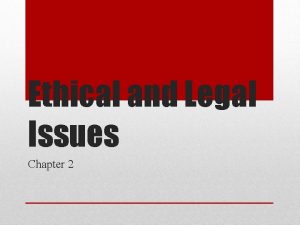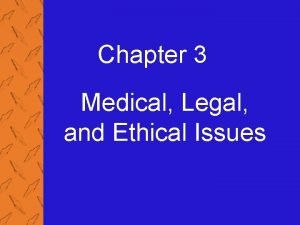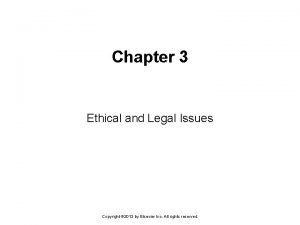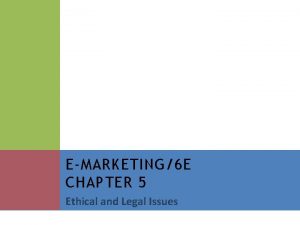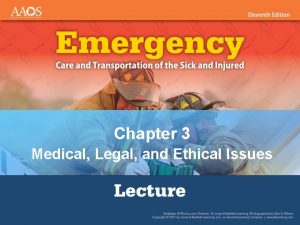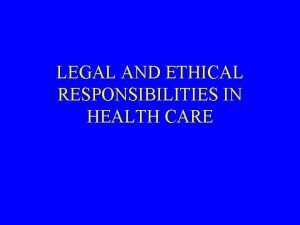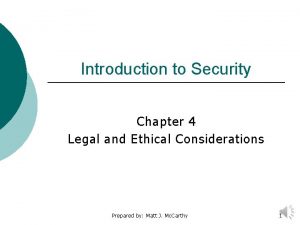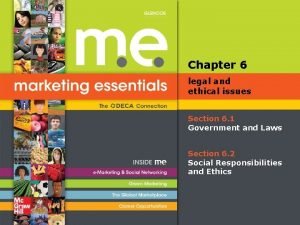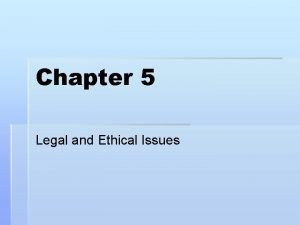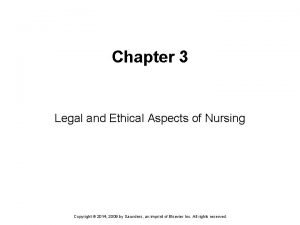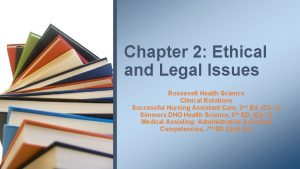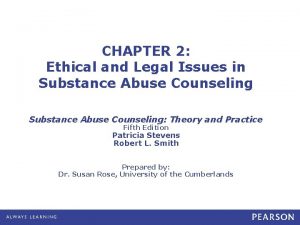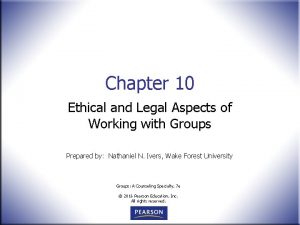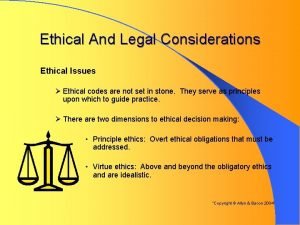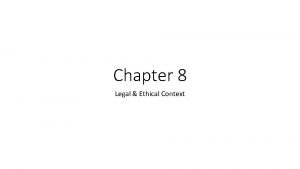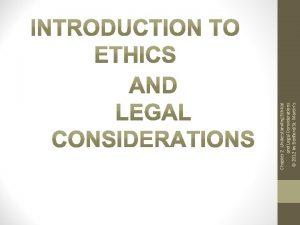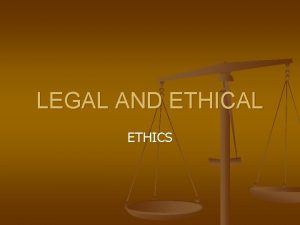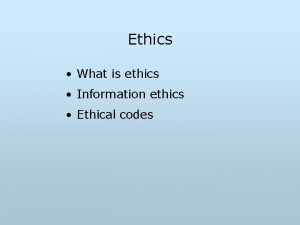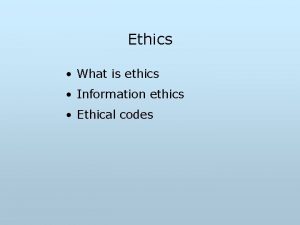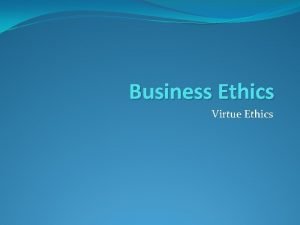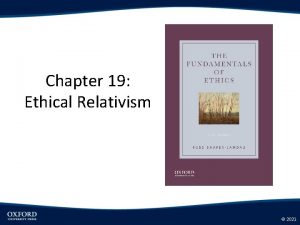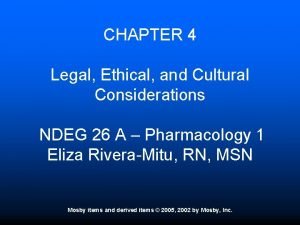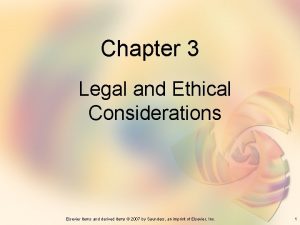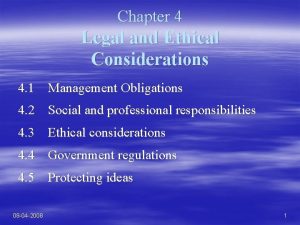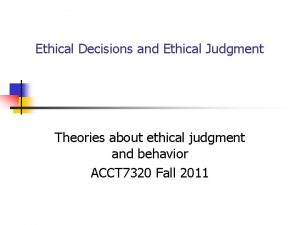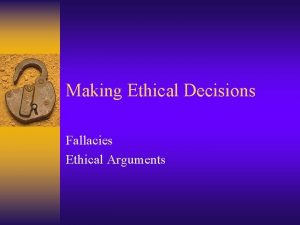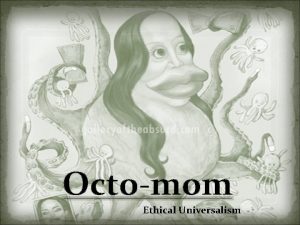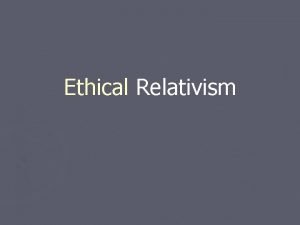Chapter 2 Understanding Ethical and Legal Considerations Ethics



















- Slides: 19

Chapter 2 Understanding Ethical and Legal Considerations

Ethics n The study of the principles of conduct that apply to an individual or a group. Gut feelings n Golden rule n Code of conduct n Law n Chapter 2. Understanding Ethical and Legal Considerations 2

Four Moral Standards Useful in Thinking About Ethical Dilemmas n Rights: n n Justice: n n How the costs and benefits of an action or a policy can be distributed fairly among a group. Utility: n n Individuals' basic needs and welfare. The positive and negative effects that an action or a policy has on the public. Care: n The relationships we have with other individuals. No rules exist to determine when one standard outweighs another Chapter 2. Understanding Ethical and Legal Considerations 3

Four Bodies of Law Relevant to Technical Communication n Copyright law n n Trademark law n n To ensure that the public recognizes the name or logo of a product Contract law n n Only the author/owner has the right to copy Agreements between two or more parties Liability law n “a lawsuit for personal injury, death, property damage, or financial loss” Chapter 2. Understanding Ethical and Legal Considerations 4

Courts consider four factors in disputes over “fair use": n n n The purpose and character of the use, especially whether the use is for profit The nature and purpose of the copyrighted work (e. g. , medical information) The amount and substantiality of the portion of the work used The effect of the use on the potential market for the copyrighted work Fair use does not apply to graphics Chapter 2. Understanding Ethical and Legal Considerations 5

Consider the following advice when using material from another source: n n n Abide by the fair-use concept. Seek permission. Cite your sources accurately. Discuss authorship questions openly. Consult legal counsel if you have questions. Chapter 2. Understanding Ethical and Legal Considerations 6

Trademark law n Trademark. A word, phrase, name, or symbol that is identified with a company. n n TM Registered trademark. A word, phrase, name, or symbol that the company has registered with the U. S. Patent and Trademark Office. n ® Chapter 2. Understanding Ethical and Legal Considerations 7

Protecting Trademarks n n Distinguish trademarks from other material. Use a trademark symbol (TM or ®). Use on first occurrence n Supplement with footnote n n n Use the trademarked item as an adjective, not as a noun or a verb. Do not use the plural form or the possessive form of the term. Chapter 2. Understanding Ethical and Legal Considerations 8

Contract Law n n Express warranty. A written or oral statement that the product has a particular feature or can perform a particular function. Implied warranty. A warranty that is not written or spoken explicitly but inferred by the purchaser. Chapter 2. Understanding Ethical and Legal Considerations 9

Guidelines for Abiding by Liability Laws for Communicators n n n Understand the product and its likely users. Describe the product's functions and limitations. Instruct users on all aspects of ownership. Use appropriate words and graphics. Warn users about the risks of using or misusing the product. Chapter 2. Understanding Ethical and Legal Considerations 10

Guidelines for Abiding by Liability Laws (cont. ) n n n Include warnings along with assertions of safety. Make directions and warnings conspicuous. Make sure that the instructions comply with applicable company standards and local, state, or federal statutes. Perform usability testing on the product and on the instructions. Make sure users receive the information. The National Association for Information Destruction (NAID) Chapter 2. Understanding Ethical and Legal Considerations 11

Characteristics of an Effective Code of Conduct n n It protects the interest of the public rather than the interests of the members of the organization or profession. It is specific and comprehensive. n n Avoids generalities (e. g. , don’t steal) It is enforceable. n Specifies penalties Texas Instruments Ethics “Quick Test” Chapter 2. Understanding Ethical and Legal Considerations 12

Whistleblowing n n Whistleblowing: The practice of going public with information about serious unethical conduct within an organization Useful n n May negatively impact the whistleblower n n if you have evidence a problem is hurting or will hurt other parties if the whistleblowing will prevent the wrongdoing only when all other internal mechanisms have been exhausted Negative performance appraisals Transfers to undesirable locations Isolation within the organization Some legal protections (Sarbanes-Oxley Act) Chapter 2. Understanding Ethical and Legal Considerations 13

Principles for Ethical Communication n n Abide by relevant laws. Abide by the appropriate corporate or professional code of conduct. Tell the truth. Don't mislead your readers. n n n Be clear (ipso facto, don’t make it overly complicated unnecessarily). Avoid discriminatory language n n False implications Exaggerations Legalistic constructions (even if technically correct) Euphemisms (offered an alternative career opportunity) even in personal communication). Acknowledge assistance from others. Chapter 2. Understanding Ethical and Legal Considerations 14

Adhering to the Laws Governing Intellectual Property n n Do not plagiarize. Honor the laws regarding trademarks. Live up to the express and implied warranties on your company's products. Abide by all laws governing product liability. Chapter 2. Understanding Ethical and Legal Considerations 15

Companies Must Communicate Ethically Across Cultures n n They have to make their communications understandable and clear for their target audiences. They are ethically obligated not to reinforce patterns of discrimination in product information. n n E. g. , workplace photos without women They are not obligated to challenge the prevailing prejudice directly. n E. g. , don’t have to show women dressed nontraditionally, but may do so if that’s their image Chapter 2. Understanding Ethical and Legal Considerations 16

Translation Faux Pas n n n n Scandinavian vacuum manufacturer Electrolux used the following in an American ad campaign: "Nothing sucks like an Electrolux. " The name Coca-Cola in China was first rendered as Ke-kou-ke-la. The phrase means “bite the wax tadpole”. Coke then researched 40, 000 Chinese characters and found, "ko-kou-ko-le, " which can be loosely translated as "happiness in the mouth. " In Taiwan, the translation of "Come alive with the Pepsi Generation" came out as "Pepsi will bring your ancestors back from the dead. " In Chinese, the KFC slogan "finger-lickin' good" meant "eat your fingers off. “ When General Motors introduced the Chevy Nova in South America, it was apparently unaware that "no va" means "it won't go. " After the company figured out why it wasn't selling any cars, it renamed the car in its Spanish markets to the Caribe. Ford had a similar problem in Brazil when the Pinto flopped. The company found out that Pinto was Brazilian slang for "tiny male genitals". Ford pried all the nameplates off and substituted Corcel, which means horse. When Parker Pen marketed a ballpoint pen in Mexico, its ads were supposed to say "It won't leak in your pocket and embarrass you. " However, the company's mistakenly thought the spanish word "embarazar" meant embarrass. Instead the ads said that "It wont leak in your pocket and. Chapter make 2. you pregnant. " 17 Understanding Ethical and Legal Considerations

Translation Faux Pas n An American T-shirt maker in Miami printed shirts for the Spanish market which promoted the Pope's visit. Instead of "I Saw the Pope" in Spanish, the shirts proclaimed "I Saw the Potato. “ n Frank Perdue's slogan, "It takes a tough man to make a tender chicken, " got terribly mangled in another Spanish translation. A photo of Perdue with one of his birds appeared on billboards all over Mexico with a caption that explained "It takes a hard man to make a chicken aroused. " n Hunt-Wesson introduced its Big John products in French Canada as Gros Jos before finding out that the phrase, in slang, means "big breasts. " It did not have a noticeable effect on sales. n Colgate introduced a toothpaste in France called Cue, the name of a notorious porno mag. n In Italy, a campaign for Schweppes Tonic Water was translated into Schweppes Toilet Water. n Japan's second-largest tourist agency was mystified when it entered English-speaking markets and began receiving requests for unusual sex tours. Upon finding out why, the owners of Kinki Nippon Tourist Company changed its name. n Clairol introduced the "Mist Stick, " a curling iron, into German only to find out that "mist" is slang for manure. Not too many people had use for the "manure stick". n When Gerber started selling baby food in Africa, they used the same packaging as in the US, with the beautiful baby on the label. Later they learned that in Africa, companies routinely put pictures on the label of what's inside, since most people can't read English. 18 Chapter 2. Understanding Ethical and Legal Considerations

Etiquette n Prescribes and restricts the ways in which people interact with each other, based on respect and customs n n n n Greeting relatives, friends and acquaintances with warmth and respect Refraining from insults and prying curiosity Offering hospitality to guests Wearing clothing suited to the occasion Contributing to conversations without dominating them Offering assistance to those in need Eating neatly and quietly Avoiding disturbing others with unnecessary noise Following established rules of an organization Arriving promptly when expected Comforting the bereaved Responding to invitations promptly Accepting gifts or favors with humility and to acknowledge them promptly Courtesy of the Wikipedia Chapter 2. Understanding Ethical and Legal Considerations 19
 Writing strategies and ethical considerations
Writing strategies and ethical considerations Ethical issues of experimental research
Ethical issues of experimental research Research design for qualitative research
Research design for qualitative research Ethical considerations examples
Ethical considerations examples Moral consideration in ethics
Moral consideration in ethics Dho chapter 5 legal and ethical responsibilities
Dho chapter 5 legal and ethical responsibilities Ethical and legal issues chapter 2
Ethical and legal issues chapter 2 Chapter 3 medical legal and ethical issues
Chapter 3 medical legal and ethical issues Chapter 3 legal and ethical issues
Chapter 3 legal and ethical issues Ch 5 legal and ethical responsibilities
Ch 5 legal and ethical responsibilities Legal and ethical issues chapter 5
Legal and ethical issues chapter 5 Chapter 3 legal and ethical issues
Chapter 3 legal and ethical issues Legal and ethical responsibilities in health care
Legal and ethical responsibilities in health care Chapter 4 legal and ethical responsibilities
Chapter 4 legal and ethical responsibilities Chapter 6 legal and ethical issues
Chapter 6 legal and ethical issues Chapter 5 legal and ethical responsibilities
Chapter 5 legal and ethical responsibilities Legal and ethical aspects in nursing
Legal and ethical aspects in nursing Chapter 2 ethical and legal issues
Chapter 2 ethical and legal issues Ethical and legal issues chapter 2
Ethical and legal issues chapter 2 Chapter 5 legal and ethical responsibilities worksheet
Chapter 5 legal and ethical responsibilities worksheet
